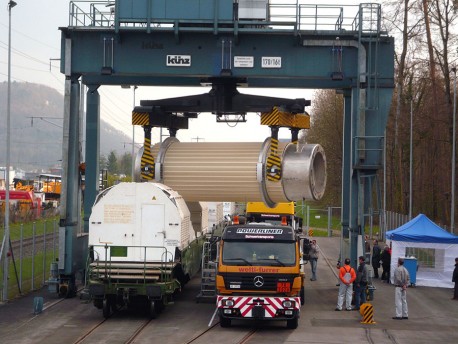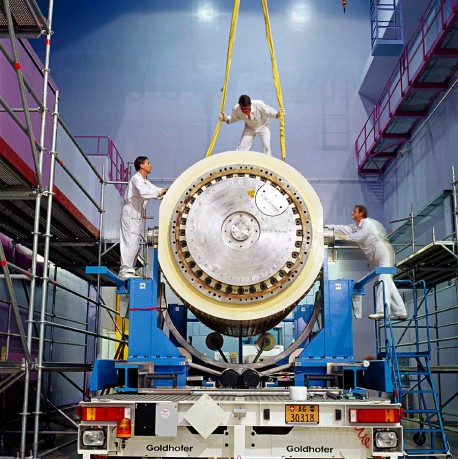Transport
Radioactive substances are transported infrequently – but on a regular basis – in Switzerland. This is because nuclear power plants are supplied with fresh fuel assemblies once per year. Conversely, radioactive waste and spent fuel assemblies are transported to the central interim waste storage facility. Transport operations of this sort are subject to very strict safety precautions in order to ensure that people and the environment are protected at all times.
The regulations in Switzerland are based on international regulations regarding the transport of hazardous goods. Licences to transport nuclear material are issued by the Swiss Federal Office of Energy (SFOE). Approval from the SFOE is based on a safety comment by ENSI. The requirements for granting a transport licence of this sort are stipulated in the Nuclear Energy Ordinance, NEO (Kernenergieverordnung, KEV).
For radioactive waste and other radioactive material that is not nuclear material, ENSI also issues licences for transport from and to nuclear plants in accordance with the legislation on radiation protection. ENSI verifies compliance with the regulations during inspections of transport which it conducts in the nuclear plants.

“CASTOR” (cask for storage and transport of radioactive material) is a term that is frequently used in connection with the transport of radioactive substances. In fact, “CASTOR” is merely a trademarked designation, so experts use “transport and storage container” as a more neutral term. Regardless of their name, these containers are of colossal size: standing about six metres high, the cylinders weigh about 130 tonnes and have massive steel walls. They are used to transport spent fuel assemblies with high-level radioactivity.
Due to their dangerous cargo, these containers must undergo rigorous loading tests involving, for example, a fire with temperatures of 800 degrees Celsius, a fall from a height of 9 metres, an aircraft crash and an immersion test in water. The containers must remain absolutely tight after each of these tests. ENSI tests the containers and issues recognition for foreign approvals in accordance with the legislation on hazardous goods; it also certifies the suitability of interim storage facilities and monitors the production of the containers intended for the storage of the material in Switzerland.
Once the containers arrive at the interim storage facility in Würenlingen, they are first tested for tightness before they are moved to the storage hall of the facility, which currently holds 34 containers (equivalent to 17% of the maximum storage capacity).

As well as high-level radioactive waste, low- and intermediate-level radioactive waste from nuclear power plants and from the medical, industrial and research sectors is also brought to Würenlingen. This waste is admitted to the Federal interim storage facility until it can be moved to a deep geological repository.

